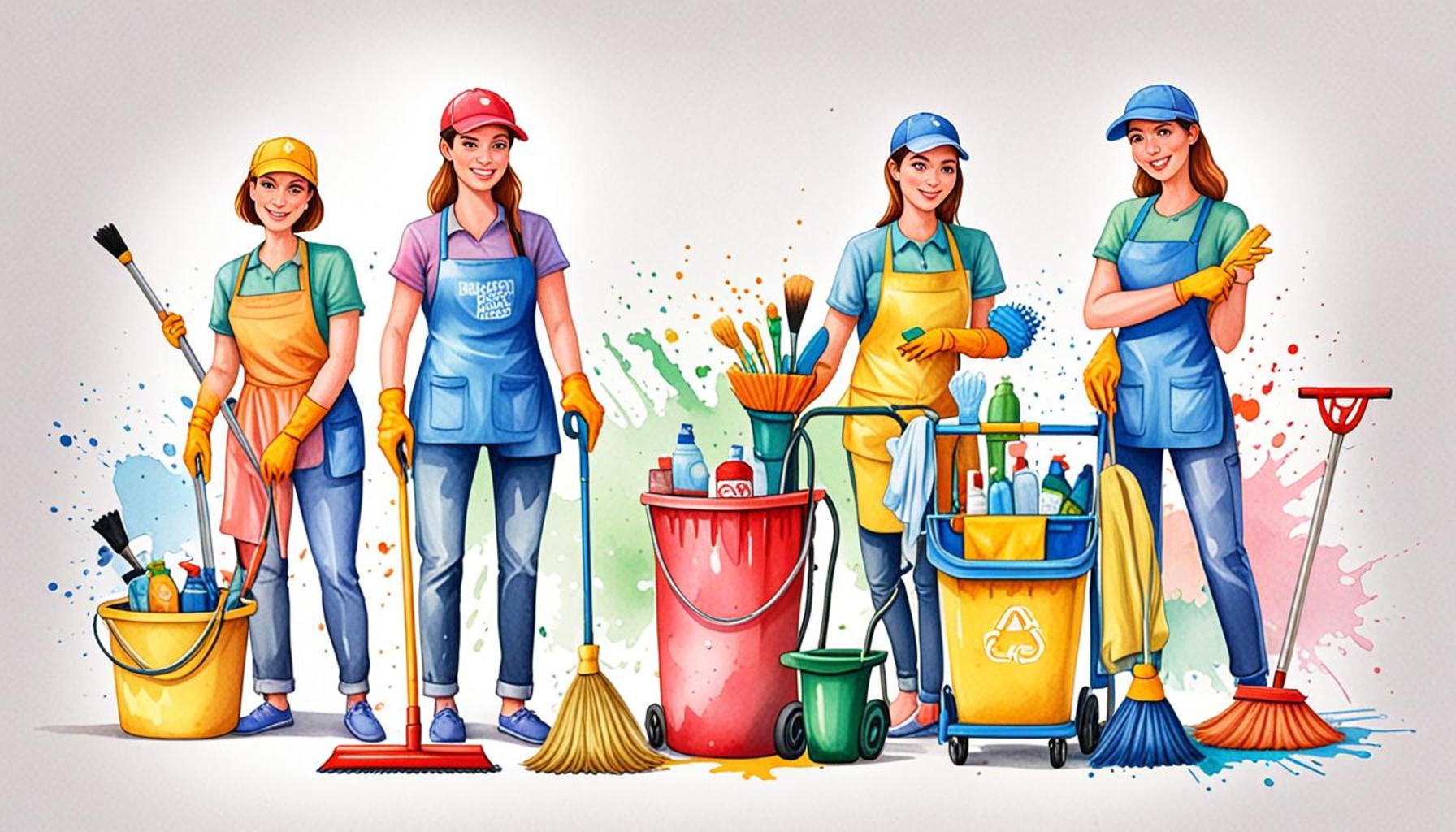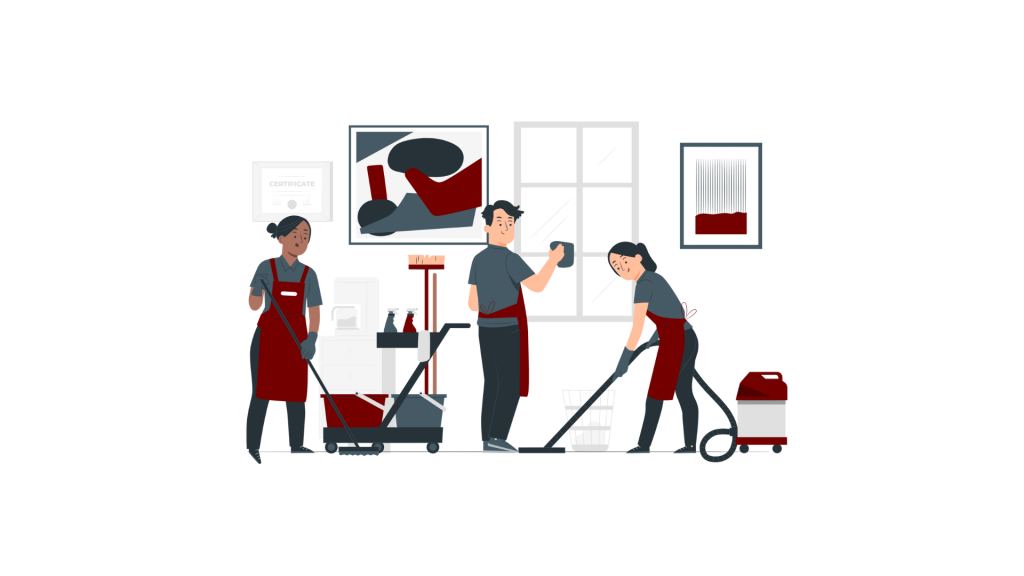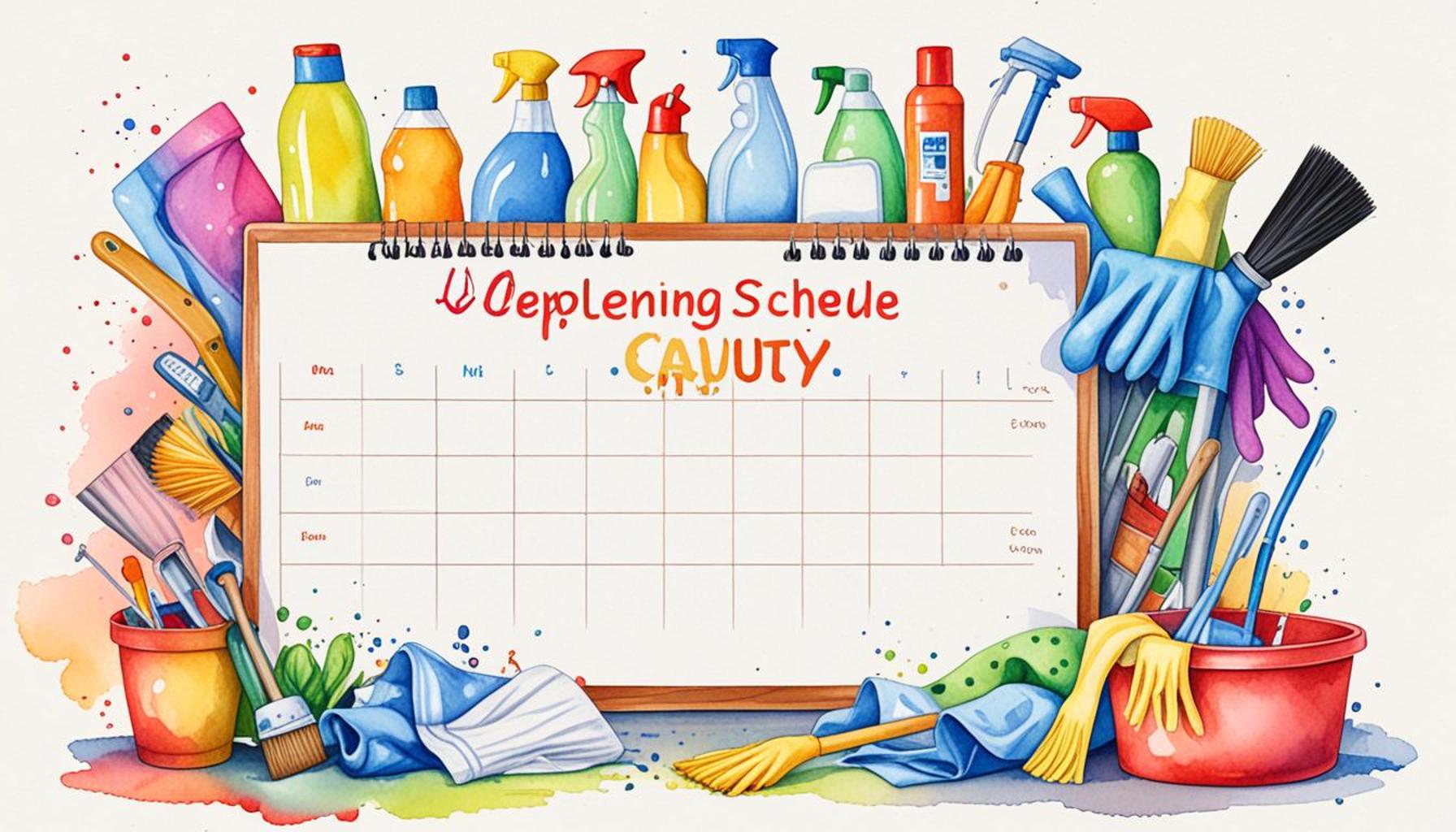Establishing a Cleaning Team: Roles and Responsibilities for Optimal Efficiency

Creating a Cohesive Cleaning Team
In today’s fast-paced environment, efficiency is key to a successful cleaning operation. Establishing a cleaning team involves not only hiring the right people but also defining clear roles and responsibilities. A well-organized team can significantly enhance productivity and quality of service, which is vital given the growing demand for sanitation in various settings, particularly post-pandemic.
Understanding the dynamics of a cleaning team can lead to optimal performance. Key roles typically include:
- Team Leader: This individual acts as the cornerstone of the operation, overseeing daily activities and managing staff members. A skilled team leader possesses excellent communication skills and is well-versed in conflict resolution, ensuring a harmonious work environment.
- Cleaning Technicians: These dedicated individuals are the backbone of the team, executing the hands-on cleaning tasks that maintain a spotless environment. From navigating specific cleaning protocols for different surfaces to employing eco-friendly products, their expertise is crucial.
- Supervisor: Responsible for ensuring quality control, the supervisor monitors the cleaning processes and provides training to technicians. This role is critical as it helps in maintaining high standards and adapting to new cleaning methodologies, such as using advanced technologies like electrostatic sprayers.
- Scheduler: Tasked with planning shifts and managing workloads, the scheduler ensures that there are enough staff members to meet demand at all times, allowing the team to function smoothly. This role involves strategic thinking and an understanding of peak cleaning times, particularly in sectors like hospitality and healthcare.
Each member plays a pivotal role in ensuring that the workplace remains clean and organized. Additionally, adhering to a clear set of responsibilities allows for smoother operations, reducing the risk of miscommunication. Implementing regular team meetings can further enhance cohesion, enabling team members to share challenges and celebrate successes together, which fosters a sense of belonging.
Investing in the right training and resources for your cleaning team can yield substantial benefits. When employees feel equipped and supported, their morale rises, leading to increased productivity and fewer turnover rates. This is particularly important in the cleaning industry, where skilled labor is often in short supply. Moreover, improved standards of cleanliness translate into heightened customer satisfaction and loyalty, ultimately driving business success.
As we delve deeper into defining roles and responsibilities, you will discover strategies for building an efficient and harmonious cleaning workforce. Exploring various training programs and continuing education opportunities for team members can uncover new techniques and industry standards that enable your team to excel.

In a competitive landscape, a cohesive cleaning team is not merely advantageous; it’s essential. Stakeholders who recognize this will not only witness improvements in their operational processes but will also cultivate a reputation for cleanliness that can set them apart in a crowded market.
DISCOVER MORE: Click here for eco-friendly cleaning tips
Defining Essential Roles for Success
Establishing a cleaning team is akin to orchestrating a symphony; each role must harmonize with the others for the overall performance to be exceptional. When outlining the roles and responsibilities, it is imperative to consider both the individual skills of team members and the collective objectives of the cleaning operation. This intricate balance can not only boost team morale but also enhance operational efficiency, thereby fostering an environment that is both clean and conducive to productivity.
Understanding the specific responsibilities of each member helps to eliminate overlap and ensures that all necessary tasks are covered. Here are the core roles to consider:
- Quality Assurance Officer: This role focuses on maintaining a high level of cleanliness and ensuring that the standards set by the organization are met. The Quality Assurance Officer performs regular inspections and assessments, documenting findings and suggesting improvements to optimize cleaning processes.
- Inventory Manager: Responsible for tracking cleaning supplies and equipment, the Inventory Manager works to ensure that the team never runs out of essential items. This role includes knowing when to reorder supplies and monitoring usage to avoid waste, which ultimately contributes to cost-efficiency.
- Health and Safety Officer: In today’s climate, maintaining safety standards is crucial. This individual oversees compliance with health and safety regulations, educating team members on proper handling of cleaning agents and techniques to reduce hazards, thereby protecting both staff and clients.
- Communication Liaison: In many cleaning operations, effective communication can make or break the team’s success. The Communication Liaison serves as a bridge between different team members and the management, facilitating the flow of information about schedules, supply needs, and any feedback regarding cleaning operations.
By clearly defining these roles, organizations can avoid possible pitfalls like overlapping duties or miscommunication, enhancing the team’s overall effectiveness. Regular training sessions designed around these roles not only fortify team members’ skills but also keep them aware of the latest industry standards and innovations, such as eco-friendly cleaning practices and advanced cleaning technologies. This ongoing education encompasses everything from product knowledge to customer service skills, ensuring that the team remains engaged and informed.
Implementing accountability measures is also paramount. Each member of the team should have performance metrics tied to their specific roles. This not only reinforces responsibility but also helps identify areas for improvement. Utilizing software tools for scheduling and task assignment can facilitate this process, making it easy to track progress and manage workloads effectively.
Ultimately, the creation of a cohesive cleaning team goes beyond simply assigning roles; it necessitates a commitment to ongoing development, communication, and a shared vision of cleanliness and professionalism. By investing in the individual strengths of each team member and fostering an atmosphere of teamwork, organizations set the stage for enhanced productivity and operational excellence.
| Key Roles | Responsibilities |
|---|---|
| Cleaning Supervisor | Oversees daily operations, ensuring staff adherence to protocols. |
| Team Coordinator | Schedules cleaning tasks, assigns duties, and manages logistics effectively. |
| Sanitation Expert | Implements sanitation standards and ensures compliance with health regulations. |
| Maintenance Personnel | Conducts routine checks, equipment maintenance, and assists in repairs. |
Establishing a successful cleaning team hinges on clearly defined roles that contribute to optimal efficiency. Among these roles, the Cleaning Supervisor plays a pivotal role in coordinating daily operations, ensuring all team members adhere to established protocols, thus fostering a culture of compliance and excellence. Next, the Team Coordinator is essential for managing schedules, assigning specific duties, and ensuring that logistics run smoothly. Additionally, having a Sanitation Expert on board is crucial for upholding rigorous sanitation standards, a vital aspect given the increasing importance of health and safety in cleaning practices. Lastly, the Maintenance Personnel ensures that all cleaning tools and equipment are in optimal working order, preventing disruptions and promoting efficiency. By laying out the roles and responsibilities in this manner, team members can focus on their specific areas of expertise, which ultimately leads to heightened productivity and improved outcomes in cleaning processes.
DISCOVER MORE: Click here for a detailed comparison
Establishing Effective Collaboration and Team Dynamics
As vital as clearly defining roles is the importance of fostering a collaborative environment within a cleaning team. Building strong interpersonal relationships among team members can significantly enhance effectiveness and morale. An efficient cleaning team operates much like a well-oiled machine; the more cohesively the parts work together, the smoother the operation will be. This coherence not only ensures that daily tasks are completed efficiently but also cultivates a supportive workplace culture.
Regular team meetings are an ideal platform for facilitating collaboration. These meetings allow team members to share insights on challenges faced during cleaning operations, brainstorm solutions, and celebrate successes. By encouraging open dialogue, organizations can harness a wealth of knowledge and experience, leading to improved strategies and methodologies. For example, a cleaning team dealing with a challenging stain on carpets may benefit from pooling their knowledge about the most effective cleaning agents or techniques, thus reducing time spent on the task in the future.
Another vital aspect of establishing a cleaning team is understanding workload distribution. The assignment of tasks should consider the individual strengths, weaknesses, and preferences of team members. Utilizing competency charts can aid in visualizing the skills of each team member and thus allow for more tailored task assignments. For instance, if one member excels in detail-oriented tasks while another prefers heavy-duty cleaning, aligning these roles with their strengths promotes optimal efficiency. This notion is rooted in the idea that, when individuals find satisfaction in their work, overall performance tends to improve.
Alongside individual strengths, it is essential to instill a strong sense of team accountability. This can be achieved through the establishment of team goals, where success is defined collectively, and rewards are shared. While individual accountability remains crucial, adding a layer of collective responsibility inspires team members to support one another and take ownership of their shared objectives. An example of this could be team members collaborating on a large-scale cleaning project, where they develop a shared action plan to ensure all areas meet quality standards and deadlines.
Additionally, incorporating technology into cleaning routines can enhance team dynamics and communication. Utilizing cleaning management software not only aids in task allocation but also helps in real-time reporting and feedback. These platforms allow team members to communicate their progress and challenges while providing management with insights into performance metrics. For instance, a mobile application can help track the completion of cleaning tasks in educational institutions, ensuring classrooms are ready for students by the time school begins.
Moreover, training is another crucial component of developing a cohesive team. Beyond initial training, ongoing education on emerging cleaning technologies, techniques, and best practices should be prioritized. This commitment to professional growth can include workshops and hands-on training sessions that not only enhance cleaning skills but also reinforce team unity. The importance of team-building exercises cannot be overstated; team outings or collaborative projects can strengthen relationships outside the day-to-day roles.
In conclusion, building a successful cleaning team extends far beyond established roles and responsibilities. By focusing on collaboration, communication, and consistent development, organizations can lay the groundwork for a cleaning team that operates at peak efficiency. Establishing an environment of support and shared goals paves the way for higher standards of cleanliness and, ultimately, enhanced workplace satisfaction.
DISCOVER MORE: Click here to learn about eco-friendly cleaning products
Conclusion: A Blueprint for Cleaning Team Success
In the pursuit of a top-tier cleaning team, the journey goes well beyond merely assigning roles and responsibilities. To achieve optimal efficiency, organizations must embrace a holistic approach that emphasizes collaboration, communication, and continuous development.
By fostering a collaborative environment, teams can cultivate strong interpersonal relationships that enhance productivity and morale. Regular team meetings facilitate problem-solving and knowledge sharing, ensuring that each member contributes to collective success. Additionally, recognizing individual strengths in workload distribution allows for tailored task assignments that maximize efficiency, ultimately leading to greater job satisfaction among team members.
The notion of team accountability is vital in establishing a supportive culture where success is shared. When team members work towards common goals, they are more likely to motivate and assist each other, thus elevating performance standards. Incorporating technology through cleaning management software provides a streamlined way to communicate progress and results, further driving efficiency.
Lastly, ongoing education and skill-building should remain a top priority. By investing in training and professional growth, organizations can equip their cleaning teams with the latest techniques and trends, ensuring they are always prepared to deliver exceptional results. As teams engage in team-building activities, they create bonds that extend beyond the workplace, enhancing camaraderie.
Ultimately, establishing a successful cleaning team requires recognizing that every element—from role definition to team dynamics—interconnects to foster a culture of excellence. By prioritizing these facets, organizations are not only ensuring their cleaning operations run smoothly but are also creating a positive workplace environment that benefits everyone involved.


